The U.S. Bureau of Economic Analysis tracks how much each state produces in a year by adding up the value created by businesses and workers in every major sector, from tech and manufacturing to farming, services, and government. That total, state GDP, works as a simple yardstick for economic size.
State GDP matters because bigger economies tend to attract more investment, support more jobs, and generate more income. States near the top usually rely on several major industries and account for a large share of what the country produces. Smaller states often have narrower economies and a lighter footprint.
Most rankings use nominal GDP, which means the numbers are shown in current dollars for that year, with no inflation adjustment. That makes it the standard way to compare size from state to state. For context, the combined nominal GDP of the United States was about $29 trillion in 2024.
With that baseline, the question becomes straightforward: which state produces the most, and how do the rest stack up?
Here Are the Latest Rankings
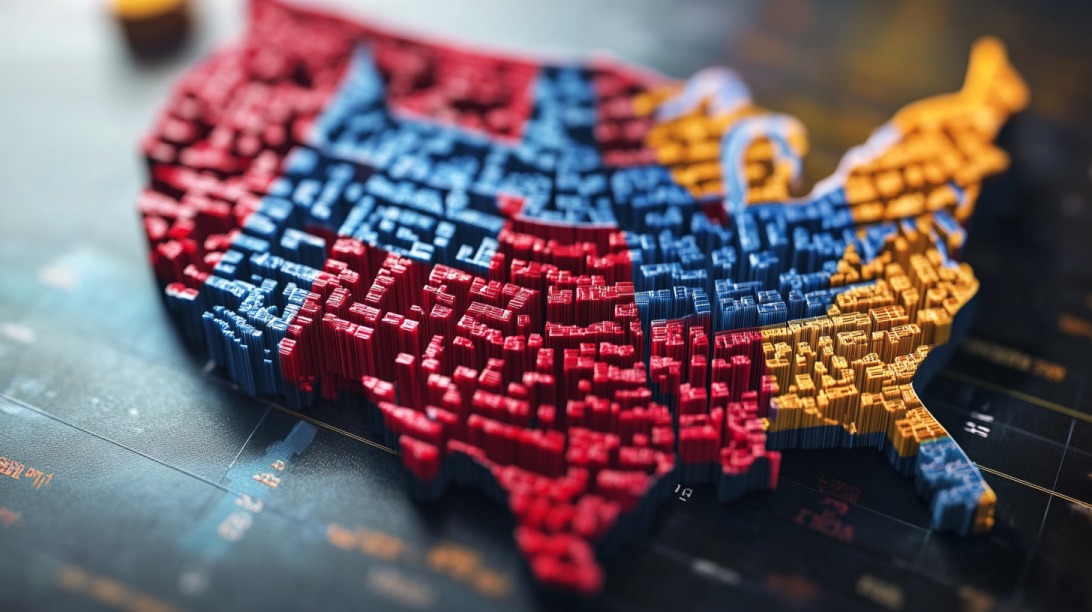
California sits at the top with the biggest economy in the country, topping $4.1 trillion in nominal GDP. On the other side of the list, the smallest state economies come in below $100 billion.
The top ten states by GDP rise well above the rest, showing how concentrated economic output is in a handful of places.
One more striking takeaway: personal fortunes can dwarf state output. Several of the wealthiest individuals on the planet hold net worth figures larger than the annual GDP of most US states, which puts the scale of modern wealth into perspective.
Here is a complete ranking list of all 50 US states plus the District of Columbia by nominal GDP, ordered from highest to lowest. All values are reported in millions of current US dollars, giving a clear view of state economic size without inflation adjustments.
| Rank | State (or D.C.) | 2024 GDP ($M) |
| 1 | California | 4,103,124 |
| 2 | Texas | 2,709,393 |
| 3 | New York | 2,297,028 |
| 4 | Florida | 1,705,565 |
| 5 | Illinois | 1,137,244 |
| 6 | Pennsylvania | 1,024,206 |
| 7 | Ohio | 927,740 |
| 8 | Georgia | 882,535 |
| 9 | Washington | 854,683 |
| 10 | New Jersey | 846,587 |
| 11 | North Carolina | 839,122 |
| 12 | Massachusetts | 780,666 |
| 13 | Virginia | 764,475 |
| 14 | Michigan | 706,616 |
| 15 | Colorado | 553,323 |
| 16 | Arizona | 552,167 |
| 17 | Tennessee | 549,709 |
| 18 | Maryland | 542,766 |
| 19 | Indiana | 527,381 |
| 20 | Minnesota | 500,851 |
| 21 | Wisconsin | 451,285 |
| 22 | Missouri | 451,201 |
| 23 | Connecticut | 365,723 |
| 24 | South Carolina | 349,965 |
| 25 | Oregon | 331,029 |
| 26 | Louisiana | 327,782 |
| 27 | Alabama | 321,238 |
| 28 | Utah | 300,904 |
| 29 | Kentucky | 293,021 |
| 30 | Oklahoma | 265,779 |
| 31 | Nevada | 260,728 |
| 32 | Iowa | 257,021 |
| 33 | Kansas | 234,673 |
| 34 | Arkansas | 188,723 |
| 35 | Nebraska | 185,411 |
| 36 | District of Columbia | 184,916 |
| 37 | Mississippi | 157,491 |
| 38 | New Mexico | 140,542 |
| 39 | Idaho | 128,132 |
| 40 | New Hampshire | 121,189 |
| 41 | Hawaii | 115,627 |
| 42 | Wisconsin | 107,660 |
| 43 | Delaware | 103,253 |
| 44 | Maine | 98,606 |
| 45 | Rhode Island | 82,493 |
| 46 | Montana | 75,999 |
| 47 | North Dakota | 75,399 |
| 48 | South Dakota | 75,179 |
| 49 | Alaska | 69,969 |
| 50 | Wyoming | 52,946 |
| 51 | Vermont | 45,707 |
As shown above, California leads by a wide margin – its 2024 GDP was roughly $4.1 trillion, making it not only the largest state economy but comparable to the GDP of many entire countries.
Texas is the second-largest at about $2.7 trillion, followed by New York around $2.3 trillion. These three states alone produce close to one-third of U.S. economic output.
At the other end, states like Vermont (around $45 billion) and Wyoming (about $53 billion) have economies that are tiny in comparison – on the order of 1% or less of California’s GDP.
Most other states fall somewhere in between these extremes.
1. California – $4.10 trillion GDP
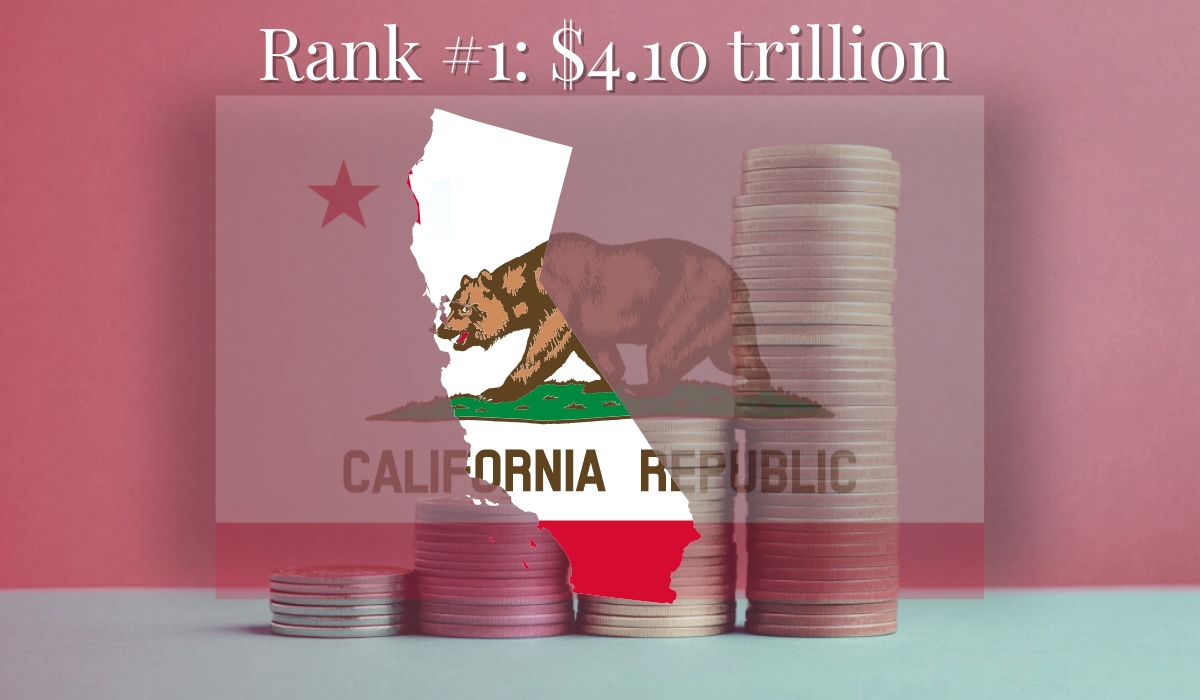
California is by far the largest state economy in the U.S., with a 2024 GDP of about $4.1 trillion.
To put this in perspective, if California were an independent country, it would rank as the world’s 4th or 5th largest economy. The state’s economic output alone accounts for roughly 14% of the entire U.S.GDP.P
Technology and Innovation
California is synonymous with the tech industry. Silicon Valley and the San Francisco Bay Area host many of the world’s largest tech companies (Apple, Google, Meta, etc.) and countless startups.
The tech sector is a key driver, accounting for nearly one-fifth of the state’s output on its own (about 19% in 2022) – a share that grows to ~30% if you include indirect effects according to advocacy.calchamber.com.
This reflects California’s role as a global center of software, internet, and semiconductor industries.
Entertainment and Media
Southern California is home to Hollywood and the U.S. film and television industry.
Major studios and streaming companies contribute billions to the state economy through film production, distribution, and related services.
Los Angeles’s entertainment sector not only produces content consumed worldwide but also supports tourism and a large workforce.
Manufacturing and Aerospace
California has a significant manufacturing base, including aerospace and defense contractors, electronics, biotechnology, and automotive design.
The state leads in high-value manufacturing – for example, building satellites, military aircraft, and advanced electronics.
Aerospace hubs in Southern California have long histories (e.g., SpaceX and legacy NASA/JPL activities) and benefit from the state’s tech talent.
Agriculture
Happy Earth Day!🌎
California’s farmers and ranchers are committed to sustainable practices that protect our planet. Today and every day, let’s celebrate the efforts to preserve our environment for future generations.#CAFarmBureau #EarthDay #Sustainability #ProtectOurPlanet pic.twitter.com/2FJ5h2BQL9
— California Farm Bureau (@CAFarmBureau) April 22, 2025
Perhaps surprisingly, given its tech industry, California is the leading agricultural producer in the United States.
The fertile farms in the Central Valley and long growing season make California a leader when it comes to the production of fruits, vegetables, nuts, and dairy.
Dairy products are the single largest farm output by value. In 2022, California agriculture generated over $50 billion in revenue.
This huge farm economy feeds into food processing industries as well.
Trade and Tourism
With major ports (Los Angeles, Long Beach, Oakland) handling seaborne trade with Asia, California is a gateway for international commerce.
International trade and logistics are foundational to the economy.
Tourism is also critical – from San Francisco to Disneyland to national parks, California attracts millions of visitors each year, supporting hospitality and retail sectors.
Underpinning California’s economy is a combination of a large, skilled workforce and world-class higher education and research institutions. The state “punches above its weight” thanks to innovation and entrepreneurship across diverse sectors, according to gov.ca.gov.
However, California’s growth has moderated in recent years. Its five-year GDP growth rate (averaging ~1.7%) has been slower than faster-growing states like Texas, due in part to high costs of living and business regulation.
Still, California’s sheer scale and broad base of industries – from Hollywood to Silicon Valley to Central Valley farms – firmly secure its place as the nation’s economic powerhouse.
2. Texas – $2.71 trillion GDP
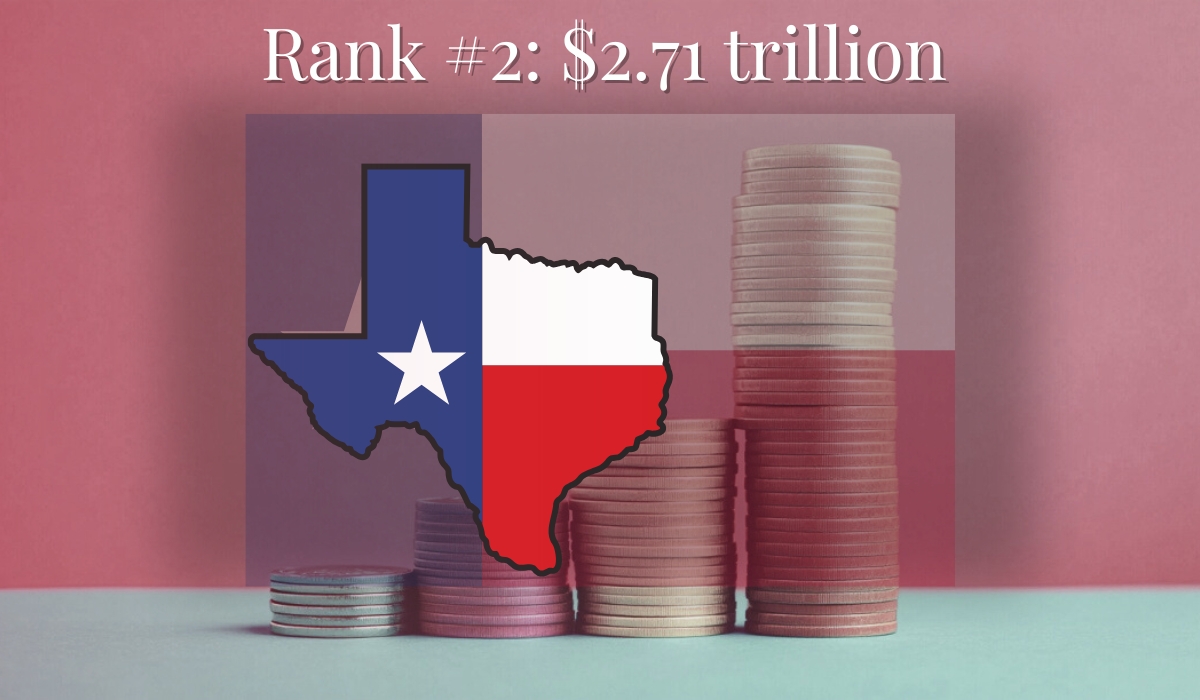
Texas had a GDP of around $2.7 trillion in 2024, making it the second-largest state economy in the U.S. If it were an independent country, it would rank as the eighth-largest economy in the world, based on figures from businessintexas.com.
The economy has grown quickly in recent years. Over the past five years, Texas averaged an annual GDP growth rate of 5.8%, well above the national average.
Energy (Oil & Gas)
Texas is the top producer of crude oil and natural gas in the U.S.
The energy sector, including drilling, refining, and petrochemicals, has been central to the state’s economy for decades. Growth has been driven by high oil prices and improvements in shale extraction.
Houston is home to many oil and gas companies and has a large network of refineries and chemical plants.
Oil and gas remain a major source of state GDP.
Technology and Innovation
Austin has become a base for software firms, startups, and facilities like Tesla’s. Dallas–Fort Worth includes several telecom and IT companies.
State records list over 17,600 tech firms in Texas, with ongoing investment in cybersecurity and biotech.
Manufacturing and Industry
यो पोस्ट Instagram मा हेर्नुहोस्
Texas has a large manufacturing sector, including petrochemical plants along the Gulf Coast, automotive assembly in cities like San Antonio and Austin, and aerospace operations tied to NASA and private contractors.
The state also produces electronics and industrial machinery.
Agriculture and Food
Large land area supports major production of cattle, cotton, and other crops. Agriculture plays a smaller economic role than energy or tech but remains part of the broader base. Ranching has deep historical roots.
Beef processing and related industries add value to raw output.
Corporate and Financial Services
More than 50 Fortune 500 companies are based in the state, with many corporate headquarters located in cities like Dallas and Houston. Finance, insurance, and real estate sectors play a major role in urban economies.
Several factors have supported recent economic and population growth: no state income tax, relatively low living costs, and minimal regulation.
These conditions have drawn both businesses and residents from elsewhere in the U.S. The state regularly ranks high in job creation and net migration.
In Q3 2023, real GDP grew at an annualized rate of 7.7%.
3. New York – $2.30 trillion GDP

New York state is the nation’s third-largest economy with a 2024 GDP of around $2.30 trillion. New York’s economic clout is anchored by New York City, the most populous city in the U.S. and a global financial hub.
The broader New York metropolitan area (which spills into New Jersey and Connecticut) generates an even larger gross metropolitan product of over $2.6 trillion.
Here are the key components of New York’s economy:
Financial Services
Lower Manhattan, where both the NYSE and Nasdaq are located, remains a base for many of the largest firms in banking, investment, and insurance.
As of 2022, financial services made up nearly a third of the state’s total economic output. That includes everything from commercial banking to asset management and insurance operations.
Access to experienced workers and proximity to global markets help sustain the sector’s size and influence.
Professional and Business Services
A large ecosystem of professional services supports New York’s economy – from law firms and consultancies to advertising, accounting, and real estate services. In 2022, professional and business services contributed roughly $245 billion to New York’s GDP. Many of these firms cluster in NYC, servicing corporate clients and the finance industry.
Healthcare and Education
With close to 20 million people, the state supports a large workforce in healthcare and social assistance. Major hospitals like NewYork-Presbyterian and Mount Sinai, along with a wide range of clinics and care providers, make the sector one of the largest employers.
New York City has a dense network of colleges and universities, while in upstate regions, institutions like the University of Rochester and its hospital system play a central economic role. The connection between higher education and medical care is especially important in those areas.
Over 7.5 million New Yorkers depend on Medicaid. Hundreds of billions in Medicaid cuts would be bad for New York and bad for America. We’re in DC talking to lawmakers directly and asking them to #ProtectOurCare. pic.twitter.com/tFqxG7PZhS
— Healthcare Education Project (@HealthEdProject) March 26, 2025
Manufacturing and Industrial
Manufacturing doesn’t dominate the economy the way it once did, but it still plays a major role, especially in high-value products.
The state produces everything from specialized machinery and electronics to chemicals and garments, with New York City’s Garment District holding historical importance for fashion.
Upstate regions continue to drive industrial output in specific areas.
Albany has become a center for semiconductor manufacturing, with facilities like GlobalFoundries operating there.
Rochester, long associated with Kodak, remains active in optics and imaging equipment.
Agriculture also contributes to the economy. The Finger Lakes and Long Island are known for wine production, making New York among the largest wine-producing states. It also ranks third in dairy and leads the nation in apple production.
Information and Media
The information sector includes companies in publishing, film, broadcasting, telecommunications, and software. Large firms like WarnerMedia, NBCUniversal, Verizon, and The New York Times are based in the city.
Often referred to as “Silicon Alley,” NYC’s tech scene includes businesses in software, digital media, and e-commerce. Film and television production has also expanded, supported by state tax incentives. The city now ranks second in the U.S. for film production, behind Los Angeles.
Manhattan alone produces a large share of the state’s GDP through finance, media, and real estate.
GDP per capita in the state exceeds $117,000, one of the highest in the country. At the same time, income inequality and high living costs are concentrated in the metro area.
Over the past five years, economic growth has been modest. The state averaged 1.3% annual GDP growth during that period. Population growth has slowed, and some finance jobs have moved to lower-cost states. Still, the financial sector remains strong. In 2024, finance and insurance employment surpassed pre-pandemic levels, according to EDC.NYC.
4. Florida – $1.71 trillion GDP
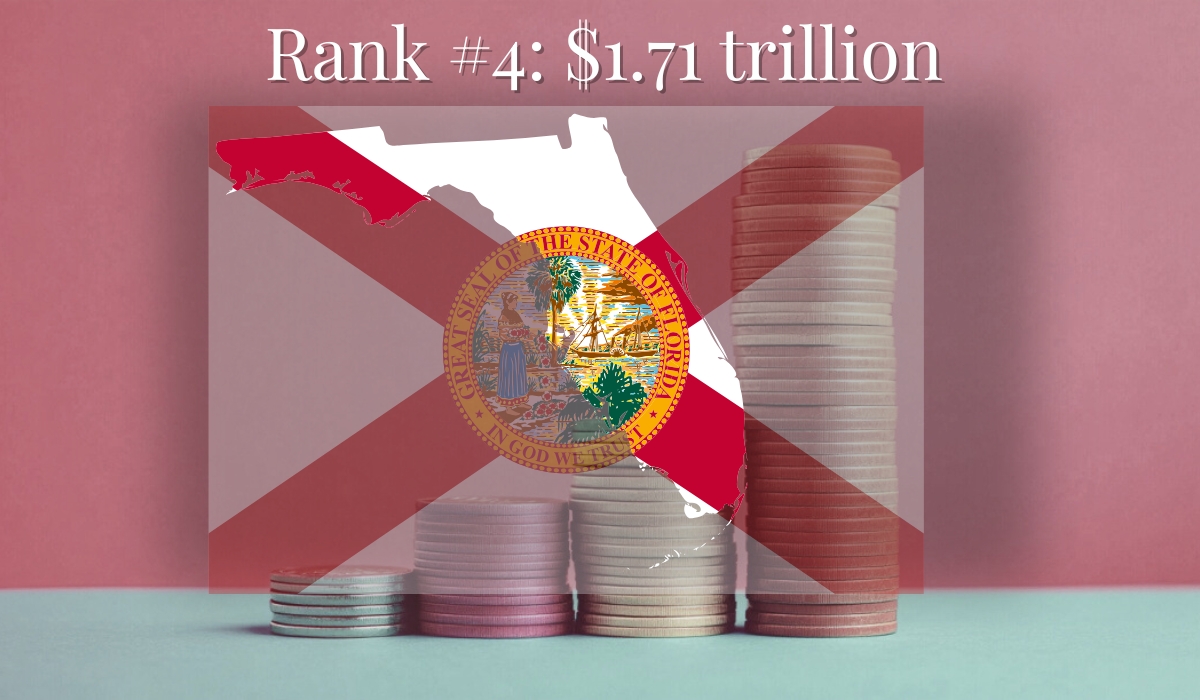
Florida’s economy has been on a rapid ascent, now ranking 4th in the nation with a 2024 GDP of about $1.706 trillion.en.wikipedia.org. Florida recently overtook states like Illinois in economic size and has firmly established itself as the largest economy in the Southeast.
Several factors and industries explain Florida’s strong economic performance:
Tourism and Hospitality
Nicknamed the “Sunshine State,” Florida is a top global tourist destination. Tourism is a cornerstone, accounting for roughly 10% of Florida’s GSP in 2023, according to flgov.com.
In 2024, Florida welcomed a record 142.9 million visitors – an all-time high. Tourists flock to attractions like Orlando’s theme parks (Walt Disney World, Universal Studios), Miami’s beaches and nightlife, the Florida Keys, and cruise ship ports.
This flood of visitors supports a huge hospitality industry: hotels, restaurants, entertainment, and retail. Even after pandemic disruptions, tourism in Florida has rebounded to record levels, driving job creation in leisure and hospitality.
Population Growth & Construction
Florida’s warm climate and lack of state income tax have attracted millions of new residents. The state’s population growth fuels a booming construction and real estate sector. There is high demand for new housing, retirement communities, and commercial development.
Construction cranes dot skylines from Miami to Tampa to Orlando. Real estate, rental, and leasing is one of Florida’s largest sectors by GDP contribution. As people and businesses relocate to Florida, this feeds into banking, retail, and services expansion as well.
Financial and Professional Services
South Florida, especially Miami, has become an international banking and finance hub, often serving as the financial gateway to Latin America. The Brickell Financial District in Miami hosts the largest concentration of international banks in the U.S.
Statewide, financial services (banks, investment firms, insurance) and professional services (law, accounting, consulting) have grown with the population and business influx. Miami and Tampa have thriving fintech and cybersecurity industries as well, nurtured by a favorable business climate.
International Trade and Logistics
Florida’s geography makes it a key player in trade. Major ports like PortMiami and Port Everglades and the Port of Jacksonville handle significant cargo, particularly trade with Latin America and Asia.
The state’s airports (Orlando, Miami, Tampa) are among the busiest, and Miami International is a crucial hub for cargo and passengers to South America. This supports logistics, warehousing, and distribution industries. The Panama Canal expansion has also benefited Florida’s ports. The state actively markets itself as a hub for hemispheric commerce.
Aerospace and Defense
Florida has a notable aerospace sector centered on the “Space Coast” (Cape Canaveral and Kennedy Space Center). It’s a launch site for NASA and private space companies (SpaceX, Blue Origin), and this segment is growing with the new space economy.
Florida also has military bases contributing to defense contracting. Simulation training and flight training is another niche (Orlando is a center for military simulation programs).
In 2023, aerospace products were Florida’s top manufacturing export (aircraft, spacecraft) – part of a manufacturing sector that also includes medical devices and electronics in the I-4 corridor.
Agriculture
The state is a leader when it comes to citrus fruits (oranges, grapefruits), sugarcane, tomatoes, and beef cattle. It supplies a large share of U.S. citrus, though citrus has faced challenges from diseases and hurricanes.
Agriculture contributes significantly to rural economies in north and central Florida.
The “Food and fiber” industries in total have a large economic impact (over $7,600 per person in output, according to the University of Florida).
Unique drivers for Florida include its attractiveness to retirees and remote workers. The influx of retirees brings income (pensions, investments) into the state and drives up demand for healthcare services (one reason healthcare is a major sector in Florida).
The economy grew 3.5% in 2024, which was well above the U.S. average, and is forecast to continue solid growth.
One potential challenge is its sensitivity to tourism trends and construction booms, which can be cyclical.
5. Illinois – $1.14 trillion GDP
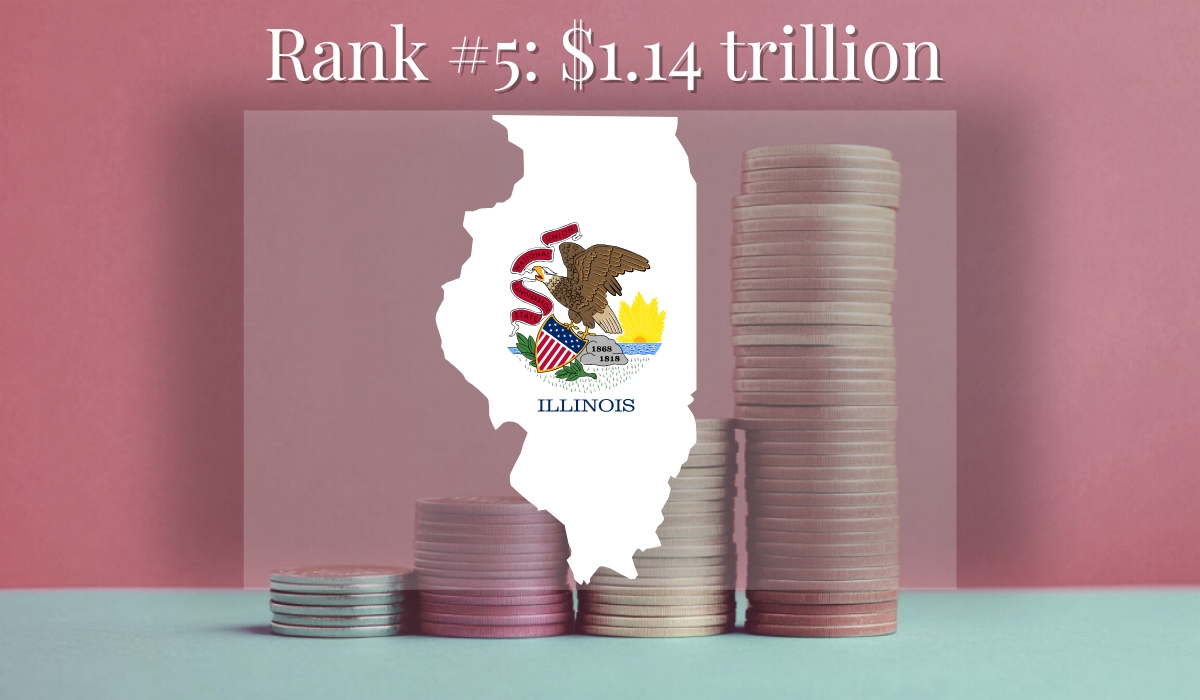
Illinois, with a 2024 GDP of around $1.14 trillion, is the largest state economy in the Midwest and ranks 5th nationally. Often hailed as having one of the most diverse economies in America,
Illinois does not rely on a single industry but hosts a broad mix of sectors:
Finance and Business Services
The Chicago metropolitan area is Illinois’s economic engine. Chicago is a global financial center second only to NYC in the U.S., with major futures and commodities exchanges (CME Group), banks, private equity firms, and insurance companies (e.g., State Farm is Illinois-based).
The professional and business services sector – including headquarters operations, consulting, legal, and accounting – is a top contributor to Illinois’s GDPdceo.illinois.gov. In 2023, professional/business services contributed about $139 billion, the largest share among Illinois industries,statista.com.
Chicago’s large corporate base (34 Fortune 500 headquarters in Illinoisdceo.illinois.govdceo.illinois.gov) ensures robust demand for these services.
Manufacturing and Industrial
Illinois has a rich manufacturing heritage. Key manufactured products include chemicals, food products, machinery, fabricated metals, electronics, and transportation equipment. As of recent data, manufacturing was the single largest private industry by GDP in Illinois, contributing over $107 billion in real value (chained dollars) in 2023,statista.com.
- Agricultural machinery (Caterpillar was founded in Illinois)
- Automotive (Illinois has assembly plants, e.g., for Stellantis Jeep in Belvidere)
- Packaged foods (Chicago is a hub for food processing companies like Kraft Heinz)
- Chemicals (Illinois’ chemical manufacturing alone was valued at $16.6B back in 2004.
The state’s central location and transportation infrastructure also support a large logistics and warehousing industry.
Agribusiness and Food Processing
Illinois is a leading agricultural state (especially in corn and soybeans). Though farming itself is a smaller slice of GDP, it underpins big agribusiness activity. Companies process Illinois grain into food ingredients, ethanol, and livestock feed.
Food processing is one of the state’s top manufacturing industries – for example, meatpacking, snacks, and dairy processing. Illinois’s fertile farmland and access to the Illinois/Mississippi river system give it advantages in agriculture and commodity transport.
Energy and Mining
Longwall mining at Hillsboro Energy’s Deer Run Mine has already permanently altered local geology. Call on @IllinoisDNR to deny a 5-year renewal of these permits—IL farmland, farmers, & our climate can’t afford 5 more years!
ACT NOW: https://t.co/7CNDZI6fwu pic.twitter.com/Qkbek4FKfO
— Illinois Sierra Club (@SierraClubIL) January 29, 2024
The state produces coal (in its southern regions) and has several oil refineries and nuclear power plants. Traditional mining is not a huge part of GDP, but renewable energy and clean tech are growing (Illinois has been expanding wind energy, for instance).
The energy sector is not as dominant as in Texas, but it provides stable jobs and input for industry.
Education and Healthcare
With Chicago and other cities (like Springfield, Peoria), Illinois has a large healthcare sector (hospitals like Northwestern Medicine, University of Chicago Medical Center, etc.) and is an education hub (University of Illinois system, Northwestern, University of Chicago). These sectors ensure significant public and private employment.
Transportation and Logistics
Sometimes called “the crossroads of America,” Illinois benefits from a world-class infrastructure network, according to dceo.illinois.gov.
Chicago is the nation’s rail hub (all seven Class I freight railroads converge there), and O’Hare International Airport is one of the busiest in the world. The state’s central location has made it a hub for trucking and distribution
Illinois’s economy is thus a balanced mix of agribusiness, advanced manufacturing, energy, life sciences, finance, and logistics. State officials tout this diversity as a strength: Illinois is “strong in agribusiness and food processing and other industries including advanced manufacturing, energy, life sciences and biotech, business and professional services, and TDL (transportation, distribution & logistics)”.
This diversity has helped Illinois weather economic cycles, though the state’s growth has been relatively modest in recent years (annualized real growth ~1% in 2022). Challenges for Illinois include population out-migration and fiscal issues, but the Chicago area economy continues to be a heavyweight.
The Chicago metro alone contributed about 80% of the state’s GDP. With its broad economic base and status as the Midwest’s financial capital, Illinois remains firmly in the top five state economies.
6. Pennsylvania – $1.02 trillion GDP

Pennsylvania’s economy, roughly $1.024 trillion in 2024, is the second-largest in the Northeast and 6th overall among states. Known as the Keystone State, Pennsylvania has a well-balanced economy with strengths in both traditional industries and emerging sectors:
Manufacturing and Industry
Pennsylvania is historically an industrial powerhouse – the manufacturing sector is still the largest contributor to Pennsylvania’s GDP, making up about 13% of the state’s output according to teampa.com.
Key manufacturing industries include advanced metals and machinery (Pittsburgh’s legacy of steel has evolved into specialty metals and high-tech manufacturing), chemicals and plastics (Philadelphia area and beyond), food processing (snack foods, chocolate in Hershey, breweries), and wood products.
Pennsylvania is also a major lumber producer, given its vast forests. In recent years, manufacturing in PA has modernized, with investments in factory automation and “Factory of the Future” initiatives. The state is even targeting manufacturing in emerging areas like electric vehicles and semiconductors (with initiatives to attract chip fabs).
Energy (Natural Gas) and Resources
Pennsylvania has become one of the nation’s top energy producers thanks to the Marcellus Shale. The state is the second-largest producer of natural gas in the U.S. (after Texas), due to the fracking boom in northern and western PA.
This has led to a petrochemical industry uptick (e.g., a new ethane cracker plant in Beaver County to produce plastics feedstock from shale gas). Pennsylvania also is a significant coal producer (though declining) and has nuclear plants powering its grid.
The energy sector – from extraction to electricity generation – is a key economic driver, especially in more rural parts. State leadership is investing in energy production and transition to ensure continued growth, as noted by pa.gov.
Agriculture and Food
Outside its cities, Pennsylvania has a robust agricultural economy. It ranks near the top in U.S. dairy production (think cows in Lancaster County), is a leading producer of mushrooms (Chester County is the “Mushroom Capital”), and produces everything from apples to Christmas trees.
Agriculture supports a large food processing industry – for instance, PA is famous for snacks (home to Hershey’s chocolate, Utz and Herr’s chips, Heinz ketchup was founded in Pittsburgh, etc.). Agribusiness remains a priority industry for the state.
Life Sciences and Healthcare
Pennsylvania has a strong concentration of life sciences companies and research. The Philadelphia region is often called “Cellicon Valley” for its cell and gene therapy industry.
The state is home to big pharmaceutical companies (Merck has large facilities in PA, for example) and medical device firms. Eight of the top 10 pharmaceutical companies have a significant presence in Pennsylvania, as noted by pachamber.org.
World-class universities like the University of Pennsylvania and the University of Pittsburgh drive biomedical research, and their affiliated hospital systems (UPenn Health, UPMC) make healthcare one of the largest employment sectors. The life sciences sector is a growing contributor to GDP, with biopharma manufacturing and R&D investments expanding.
Technology and Robotics
Pittsburgh has reinvented itself as a tech and robotics hub, leveraging Carnegie Mellon University’s expertise. The city has attracted offices for Google, Uber (self-driving car lab), and many robotics startups. Philadelphia also has fintech and IT firms.
While Pennsylvania is not as high-tech as California or Texas at large, these innovation clusters contribute to its growth. State initiatives in robotics, AI, and semiconductors aim to further grow the tech footprint.
Logistics and Transportation
Strategically located, Pennsylvania is crisscrossed by interstate highways (I-76, I-80, I-95, etc.) and a major freight rail corridor.
The distribution and logistics industry is important in regions like the Lehigh Valley and central PA, where many warehouses and fulfillment centers (including Amazon centers) have sprung up to serve East Coast markets. This has created jobs and added to GDP in the trade and transportation sector.
Pennsylvania’s government has been actively investing to boost these key industries. In 2024, the state launched a new economic development strategy focusing on agriculture, energy, life sciences, manufacturing, and technology.
Governor Shapiro secured over $3 billion in private sector investments for such industries in 2024.
One example: construction of new biotech labs and expansions of natural gas processing facilities. Manufacturing, as noted, is seeing a resurgence with advanced methods and was identified as a path for the state’s future growth.
Pennsylvania’s economy grows at a moderate pace (its real GDP grew about 2.5% in 2023–2024), but its well-rounded mix of industrial might, energy resources, and Eds-and-Meds keeps it in the top tier of state economies.
Pittsburgh and Philadelphia serve as dual economic anchors on each end of the state – one traditionally industrial and now tech-leaning, the other heavy in education, pharmaceuticals, and finance. Together, they make Pennsylvania a formidable economic player.
7. Ohio – $927.7 billion GDP
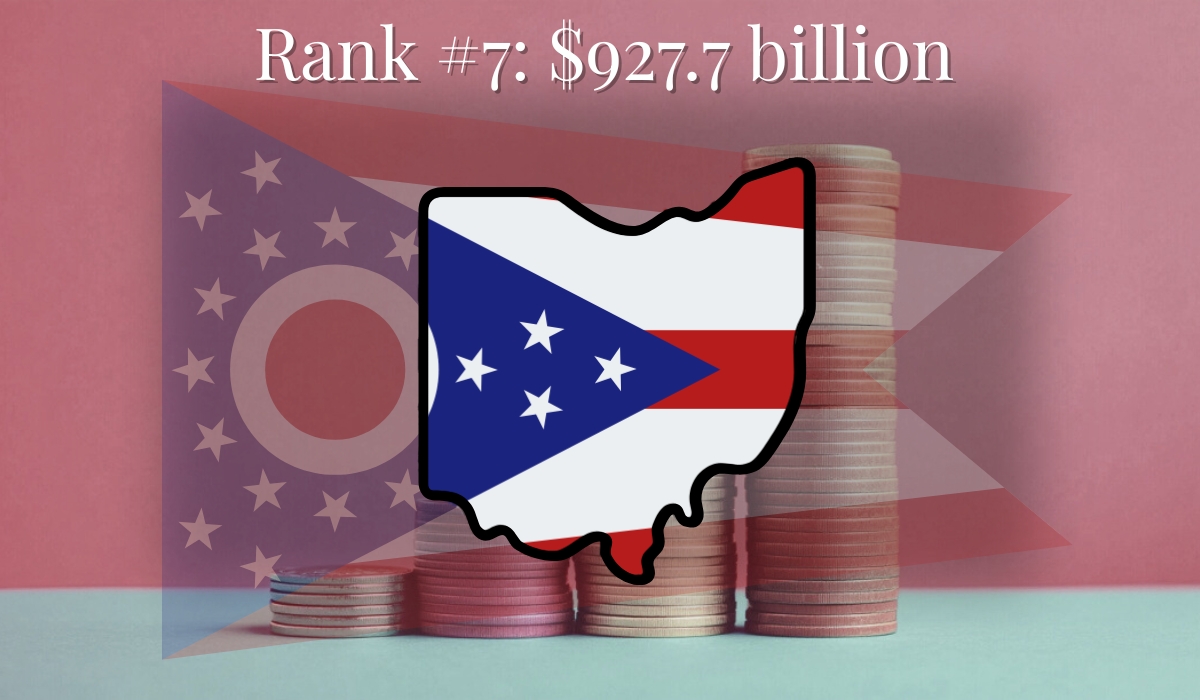
Ohio’s economy, with a 2024 GDP of about $927.7 billion, is the largest among the Great Lakes states after Illinois and ranks 7th in the nation. Ohio has a long history as a manufacturing titan, and while it has diversified, manufacturing remains central to its economy:
Manufacturing Strength
Ohio is often referred to as the “industrial capital” of the Midwest. Manufacturing is the largest of Ohio’s 20 economic sectors – in 2022, it accounted for roughly 15.7% of Ohio’s total output, the highest share of any sector, including government, as noted by ohiomfg.com.
Ohio’s manufacturing GDP is the third-largest among states, behind only California and Texas.
- Plastics and rubber products (Akron is famous for tire and rubber companies like Goodyear)
- Autos and auto parts (Ohio is the #2 automaker in the U.S., producing cars and trucks in plants for GM, Ford, and Honda)
- Steel and metals (Cleveland and Youngstown have steel mills)
- Household appliances and machinery, and aircraft engines (GE Aviation is headquartered in Cincinnati, making jet engines, contributing to aerospace manufacturing).
Financial Services and Headquarters
Columbus has seen steady growth in both finance and tech, with companies like Nationwide Insurance and Huntington Bancshares headquartered there. The city has also attracted fintech startups and investment firms in recent years.
Cleveland is home to major banks and insurers, including KeyBank and Progressive. It also benefits from the presence of the Cleveland Clinic, one of the region’s largest employers and a driver of related economic activity.
In Cincinnati, companies such as Procter & Gamble, Macy’s, and Kroger maintain a strong corporate footprint. Their operations contribute significantly to jobs and output in the area.
Healthcare and Education
Institutions such as the Cleveland Clinic, Ohio State University, and the University of Cincinnati Medical Center contribute heavily to local economies.
Ohio has the largest bioscience workforce in the Midwest. Areas like biomedical research and medical device production continue to see steady investment and output.
Logistics and Distribution
Cities like Columbus and Toledo have developed into major distribution points, supporting industries like retail, e-commerce, and auto manufacturing.
The trade, transportation, and utilities sector employs more Ohioans than any other industry. Interstate routes like I-70, I-75, and I-71 run through the state, giving trucking companies fast access to markets across the Midwest and beyond.
Rickenbacker handles nonstop cargo traffic for companies moving goods across the region.
Energy and Chemicals
Ohio has a mix of energy resources – it produces natural gas and oil (part of the Utica Shale formation lies in Ohio), has coal in the southeast, and a growing renewable energy sector (wind farms in northwest Ohio).
The chemical industry in Ohio is significant, benefiting from both the state’s manufacturing heritage and feedstocks from regional petroleum refining. Ohio is a top producer of plastics and rubber products, as mentioned, which ties into both the manufacturing and chemical sectors.
Agriculture
Agriculture remains an important part of Ohio’s economy (though relatively small in GDP). About 1 in 7 Ohioans works in agriculture or food-related industries. Ohio farms produce soybeans, corn, hogs, dairy, and poultry in large quantities.
Food processing (from soybean oil refining to meatpacking) is notable in Ohio’s non-metro areas. Companies like Smucker’s (jam and jellies, based in Orrville, OH) highlight the intersection of farming and manufacturing.
Ohio’s state development arm emphasizes that the economy is diversifying with multiple industries beyond its rust-belt image. Recent initiatives have focused on technology: for example, Intel is investing in new semiconductor factories near Columbus (a major win for Ohio in 2022), which could make the state a semiconductor manufacturing hub.
The state also has an emerging presence in fuel cells and green energy (dubbed the “Fuel Cell Corridor” in the Dayton area) and is marketing sites for electric vehicle supply chain investment. The aerospace and defense industry employs over 16,000 Ohioans, centered around Wright-Patterson Air Force Base in Dayton and GE’s jet engine operations.
8. Georgia – $882.5 billion GDP

Georgia’s economy has been expanding rapidly, reaching a 2024 GDP of about $882.5 billion, which ranks 8th among states. It is the largest economy in the Deep South. Georgia has cultivated a diverse economy with particular strengths in recent years in manufacturing and tech, while leveraging its traditional advantages in logistics and agriculture:
Advanced Manufacturing (Automotive and Aerospace)
Georgia has become a hotspot for advanced manufacturing, especially in the automotive and electric mobility sectors. The state has attracted major new investments such as the SK Battery America plant and multiple electric vehicle (EV) facilities.
Since 2018, over $27 billion in investments have been announced in Georgia’s “e-mobility” supply chain (EV assembly, battery production, etc.), creating more than 32,000 jobs according to georgia.org.
Companies like Kia (which operates a large auto assembly plant in West Point), Hyundai (building a massive EV plant near Savannah), and Rivian (planning a new EV factory) are putting Georgia on the map as an automotive hub.
Additionally, aerospace and defense is a legacy industry: Georgia is home to Gulfstream Aerospace in Savannah (manufacturer of private jets) and Lockheed Martin’s Marietta plant (which assembles military aircraft).
Aerospace products are Georgia’s top export, totaling $11.1 billion in recent data. The state’s aviation sector includes Delta Air Lines (headquartered in Atlanta) and a large maintenance/repair ecosystem around Hartsfield-Jackson airport. These manufacturing strengths meant that in FY2024, over half of Georgia’s major business expansions were in manufacturing (automotive, aerospace, etc.)
Logistics and Transportation
Georgia’s geography and infrastructure make it a logistics powerhouse.
Atlanta is often called the “Logistics Capital of the Southeast.” Hartsfield-Jackson Atlanta International Airport is the busiest airport in the world, underpinning a huge travel and cargo business.
The Georgia Ports Authority runs the Port of Savannah, the third-busiest container port in the U.S., and the Port of Brunswick, a major auto-shipping port (second-busiest for roll-on/roll-off vehicles).
These ports have seen booming volumes, reinforcing Georgia as a gateway for trade. The state also has an extensive rail and interstate highway network (I-75, I-85, and I-20 intersect in Atlanta). As a result, many distribution centers and warehouses (Amazon, Home Depot, etc.) are located in Georgia.
Logistics and distribution a key sectors supported by this infrastructure.
Technology and Fintech
Atlanta has emerged as a significant tech hub, particularly in financial technology (Fintech) and digital media.
The city is sometimes nicknamed “Transaction Alley” because a large portion of U.S. payment processing transactions pass through Atlanta-based companies (like Global Payments, NCR, Intercontinental Exchange).
Georgia has over 200 fintech companies, and the state’s tech sector is bolstered by talent from Georgia Tech and other universities. Furthermore, Atlanta is home to major tech offices and data centers; for example, Microsoft and Google have large presences.
The state promotes itself in the technology sector, with growing clusters in cybersecurity and digital health.
Film and Entertainment
One of Georgia’s more prominent success stories is its film and television production industry. Generous tax incentives turned Georgia into the “Hollywood of the South.” In FY2024, film/TV productions spent an estimated $2.6 billion directly in Georgia, as noted by atlantafi.com.
At any given time, dozens of productions are filming around Atlanta and other parts of the state. Georgia now boasts over 5.6 million square feet of sound stage space (second only to California).
Blockbuster movies (Marvel’s Avengers films, for example) and popular TV series are shot in Georgia, supporting an estimated 60,000 industry jobs statewide. This rapid growth of the entertainment sector has diversified Georgia’s economy and made it a cultural production center as well as an economic one.
Agribusiness and Food
Georgia remains a major agricultural state. Its nickname, the “Peach State,” highlights one famous crop (peaches), but Georgia is #1 in the U.S. for peanuts, pecans, and poultry (broilers) – sometimes referred to as the “four P’s” of Georgia agriculture (peanuts, pecans, peaches, poultry).
Chicken production is especially massive; Georgia is the top broiler chicken producer, which feeds a large poultry processing industry.
Other important outputs are cotton, blueberries, and timber. Agriculture and related food processing (e.g., chicken processing plants, peanut product factories) are cornerstones, particularly in South Georgia. The University of Georgia estimates food and fiber industries have a multi-billion-dollar impact on the state economy.
Corporate Services
Atlanta is home to many Fortune 500 headquarters (Coca-Cola, Home Depot, UPS, Delta, among others).
This concentration means significant activity in corporate management, marketing, and other professional services. It also fuels a large convention and tourism business in Atlanta.
Georgia’s pro-business environment (consistent top rankings for business climate) and extensive economic development efforts have yielded continuous investments. During FY2024, Georgia saw over 400 facility expansions and new projects announced.
The state government highlights that it must keep investing in infrastructure and workforce to sustain this growth.
Real GDP in Georgia grew by 3.1% in 2024, higher than the U.S. rate, and the outlook remains positive, albeit with a slight slowdown expected.
Overall, Georgia’s economy is powered by a mix of modern industry (EVs, aerospace, fintech) and traditional sectors (logistics, agriculture).
This balance, along with Atlanta’s role as the economic heart of the Southeast, explains Georgia’s climb into the top ten state economies.
9. Washington – $854.7 billion GDP

Washington state’s economy is the largest in the Pacific Northwest, with a 2024 GDP of about $854.7 billion. It ranks 9th nationally.
Washington has a dynamic, innovation-driven economy anchored by a few dominant industries:
Technology (Software and E-commerce)
The Seattle area propels Washington’s economy with its world-renowned tech sector. Microsoft, based in Redmond, and Amazon, headquartered in Seattle, are two of the biggest companies on the planet and together contribute enormously to the state’s GDP.
The broader information and communications technology (ICT) industry – including software development, cloud computing (Amazon Web Services is a major player), and internet retail – has made Washington a magnet for STEM workers.
Washington has the nation’s highest concentration of STEM workers in its workforce. The information sector (which covers software, online services, telecom, etc.) is one of Washington’s leading economic sectors by output.
Other tech companies like Google, Facebook (Meta), and Nintendo have significant offices in the state as well. This tech boom contributes to Washington’s high GDP per capita (over $108,000 in 2024, one of the highest).
Aerospace
For decades, Washington has been synonymous with Boeing. Although Boeing relocated its corporate headquarters, the Puget Sound region remains Boeing’s primary production center for commercial aircraft (such as the 737, 767, 777, and components of the 787 Dreamliner).
The aerospace manufacturing industry employs tens of thousands and supports a network of suppliers. Washington is home to the largest aerospace cluster in the U.S., specializing in aircraft assembly and advanced materials.
Aerospace and related defense manufacturing have been a cornerstone of Washington’s economy, making the state a top exporter of airplanes. Even as Boeing faces global competition, it continues to be a major GDP contributor.
Additionally, Washington has a growing space industry presence (Blue Origin, founded by Jeff Bezos, is based in Kent, WA).
International Trade and Logistics
在 Instagram 查看这篇帖子
With its strategic location on the Pacific Rim, Washington handles a large volume of trade with Asia.
The Port of Seattle and Port of Tacoma (together the Northwest Seaport Alliance) form one of the biggest cargo port complexes in North America. Key exports include airplanes, agricultural products, and tech equipment, while imports (consumer goods, cars, etc.) come through for distribution across the country.
Washington’s foreign trade with Asia is substantial, and companies like Costco (also headquartered in WA) rely on this trade flow. The state’s economy benefits from businesses involved in shipping, logistics, and warehousing due to trade.
Agriculture and Food Products
Eastern Washington’s Columbia Valley is one of the nation’s most productive agricultural regions. Washington is the #1 U.S. producer of apples (about two-thirds of the nation’s apples), as well as a top producer of cherries, hops (for beer), pears, and grapes (wine industry).
Wheat and potatoes are also significant. Food processing (e.g., fruit packing, french fry manufacturing) adds value. Agriculture may only form a few percent of state GDP, but it’s important regionally and for exports.
Notably, Washington’s Yakima Valley and Walla Walla regions have established a world-class wine industry (Washington is #2 in wine production after California).
Forestry and Wood Products
Washington has vast forests and a historic timber industry. Companies in wood products, paper, and forestry still contribute, though less than in the past. The state remains a large producer of lumber and paper (Weyerhaeuser, one of the world’s biggest timber companies, is based in Washington).
Forestry products are among the leading sectors cited by state commerce
Clean Energy
Washington is blessed with abundant hydroelectric power (the Columbia River’s dams). Hydroelectric power is a notable sector – it provides inexpensive electricity that supports industries like aluminum smelting (in the past) and today’s data centers.
The state is also investing in wind and solar, and in electric systems for transportation. Clean tech and environmental tech have room to grow in Washington’s economy.
One unique factor for Washington: Government and real estate are technically the top sectors by share of GDP, as in many states, but in Washington’s case, the information sector (tech) is very close behind. In 2016, government, real estate, and information were the top three sectors, and manufacturing (which includes aerospace) was fourth at 8.6% of GDP. This underscores how tech and services have surpassed manufacturing in share. Still, manufacturing (driven by Boeing and others) is vital.
10. New Jersey – $846.6 billion GDP

New Jersey rounds out the top ten with a 2024 GDP of about $846.6 billion. Despite being one of the smallest states by area, New Jersey has a dense population and a diverse, high-income economy. Its economic profile is heavily influenced by its proximity to New York City and Philadelphia, but New Jersey also hosts powerful industries of its own:
Pharmaceuticals and Life Sciences
New Jersey is often dubbed “the Medicine Chest of the World.” It has a rich concentration of pharmaceutical and biotech companies.
The state is home to 13 of the world’s 20 largest pharmaceutical companies, including Johnson & Johnson (headquartered in NJ), Merck, Novartis, Bristol-Myers Squibb, and Pfizer’s substantial operations. The pharma industry in NJ has historical roots dating back to the late 19th century and continues strong, from drug R&D to manufacturing.
New Jersey also boasts the highest concentration of scientists and engineers per square mile in the U.S., as noted by chosenj.com, feeding its life sciences dominance.
Biotech firms and medical device makers also thrive, supported by research institutions like Princeton and Rutgers. This life sciences sector is a major contributor to state GDP and a key driver of growth in recent decades.
Financial Services
Thanks to its proximity to Manhattan (many firms have back offices or secondary offices in NJ) and its fluent customer base, New Jersey has a significant finance and insurance sector.
Newark and Jersey City, right across the Hudson River, have become extensions of Wall Street – hosting operations for banks, asset managers, and insurers. For instance, Prudential Financial is headquartered in Newark.
The state’s financial services industry leverages a specialized workforce (including graduates from Stevens Institute and Rutgers) and contributes substantially to the economy.
Additionally, many NYC commuters live (and spend) in NJ, supporting local financial advisory and real estate services.
Advanced Manufacturing and Chemicals
New Jersey has a long industrial heritage in chemicals, petroleum refining, and manufacturing. Bayonne and Newark have refineries (though smaller now), and companies like BASF and Dow have chemical plants or R&D in NJ.
The state produces pharmaceuticals (overlap with life sciences), flavors and fragrances (e.g., IFF in NJ), and advanced materials. Advanced manufacturing remains a focus, especially in areas like precision instruments and aerospace components.
For example, Honeywell (until recently headquartered in NJ) has a presence in aerospace/defense manufacturing. Manufacturing in total is a smaller share than in the Midwest states, but still significant (about 11% of NJ’s GDP in 2022 came from manufacturing, per NAM data).
Transportation, Logistics, and Distribution
New Jersey is a critical logistics hub for the East Coast. The Port of Newark/Elizabeth, part of the Port of New York and New Jersey, is the busiest seaport on the U.S. East Coast. Vast quantities of imports (from Europe and Asia via the Suez) enter through New Jersey’s port facilities.
This supports a huge warehousing and trucking industry in northern and central NJ.
The state’s highways and rail lines shuttle goods to the dense Northeast markets. Major retailers operate distribution centers along the NJ Turnpike corridor.
Additionally, Newark Liberty International Airport is a global air cargo gateway. The logistics sector thus plays a key role in New Jersey’s economy, capitalizing on its location.
Information Technology and Telecom
New Jersey was a historic center for telecommunications research – Bell Labs in Murray Hill famously invented the transistor. Today, NJ’s telecom legacy continues with many data centers and IT companies in the area (Verizon has significant operations, and AT&T’s research remained for years).
The state also supports a growing film/digital media sector (though neighboring New York often overshadows it, NJ has studios and receives spillover TV/film productions with its tax incentives.
Tourism and Gaming
Along the Jersey Shore and in Atlantic City, tourism is a notable contributor. Atlantic City’s casino industry, though past its 1980s heyday, still generates revenue and jobs. Beach towns bring seasonal tourism spending.
Overall, tourism (including shore tourism) contributes around $47 billion to NJ’s economy (pre-pandemic levels) – not as much as Florida or Nevada, but significant locally.
New Jersey’s high ranking in GDP is also tied to its high incomes and productivity. It regularly ranks near the top in median household income. The state’s economy grew modestly around 1-2% in recent years.
One trend has been the expansion of the biotech and pharma corridor along the I-95 and I-287 areas, especially as some companies consolidate operations in NJ (for example, Eisai and Cambria announced moves to NJ). The state actively promotes key sectors: “New Jersey’s diverse economy includes major pharmaceuticals, life sciences, financial services, advanced manufacturing, information technology, and logistics.
This encapsulates its multi-faceted strengths. Being densely populated, New Jersey also has a large healthcare and education sector to serve residents, and consumer services thrive in its wealthy suburbs.
The Bottom Line
California, Texas, and New York had the highest state GDPs in 2024. Combined, they account for a large portion of the $29 trillion U.S. economy.
Each state gets there differently. California leans on tech and entertainment, Texas on energy and manufacturing, and New York on finance and media. The numbers are big, but they don’t explain everything.
GDP alone doesn’t show how people actually live. A state might have a huge economy but still deal with high costs, income gaps, or job market issues.
That’s why it makes more sense to also consider factors such as income per person, the cost of living, and the conditions related to the ongoing development of various industries.


